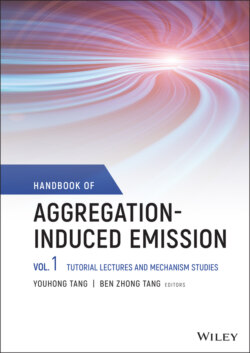Читать книгу Handbook of Aggregation-Induced Emission, Volume 1 - Группа авторов - Страница 17
1.2.2 Restriction of Intramolecular Vibration
ОглавлениеApart from the intramolecular rotation, the intramolecular vibration in the luminogens‐lacking rotors can also cause emission quenching in the dilute solution. Bu et al. have found that two coumarin derivatives fused with five‐membered and seven‐membered alkyl rings, respectively, show totally different photophysical behaviors, despite their similar conjugation degrees in the ground state, as indicated by the similar ultraviolet (UV)–vis absorption spectra presented in Figure 1.2 [10a].
The compound CD‐5 with a five‐membered ring is much more rigid and can show strong light emission in the dilute solution, but its emission is weakened in the solid, whereas the CD‐7 is almost nonemissive in the dilute solution, but it can show enhanced light emission in the solid state. The calculated conformations of these two derivatives have revealed that the CD‐7 with seven‐membered ring owns much higher vibrational flexibility in the excited state. The central π‐conjugated plane of CD‐7 will suffer the vibrational motion with a dihedral angle of around 18°, so its emission can be easily quenched in the dilute solution. But such intramolecular vibration can be efficiently restricted in the solid state, which finally leads to the AIE phenomenon. The mechanism for such AIEgens‐lacking rotors has been concluded as the RIV.
However, it remains unclear what the driving force is for the vigorous molecular motions on the excited state. Zhao et al. have recently systematically investigated the structure–property relationship of a series of annulene‐based AIEgens and figured out the driving force of the strong vibrations in the excited state [10]. The parent cyclooctatetrathiophene (COTh) contains an eight‐membered ring fused by four thiophene rings and takes a noncoplanar and saddle‐like conformation as presented in Figure 1.3b. Such a highly twisted structure makes COTh nonaromatic in the ground state. The COTh shows typical AIE behavior that it can only emit negligible light in the dilute solution but shows enhanced green emission in the aggregate and solid film. The optimized structure of COTh in the ground state is similar to its single crystal structure, whereas it can relax to a transition state with a planar conformation, and finally decay through fast nonradiative pathways to the ground state. Through the calculation of the nucleus‐independent chemical shift (NICS) and anisotropy of the induced current density (ACID) to characterizing the aromaticity of the structures, it has been revealed that the aromaticity reversal from the ground state to the excited state drives the conformational change through intense up–down vibration. But when the aggregation occurs, the vibration can be effectively restricted due to the environmental hindrance. Meanwhile, the energy of the planar transition state has been elevated, and the pathways to the transition state are not energetically accessible, which leads to the major radiative decay and promoted luminescence efficiency.
Figure 1.2 (a) UV–vis absorption and (b) photoluminescence (PL) spectra of coumarin derivative‐7 (CD‐7) and coumarin derivative‐5 (CD‐5) in CH2Cl2. Concentration: 10−5 M; excitation wavelength: 411 nm. (c) Optimized structures at the S0,min and S1,min of CD‐7 in the gas and solid phases and CD‐5 in the gas phase at time dependent (TD) M062X/6‐31G(d) level.
Source: Adapted from Ref. [10a] with permission from John Wiley and Sons.
From the abovementioned cases, it can be concluded that RIR and RIV are the main cause of the AIE properties of propeller‐shaped and shell‐shaped AIEgens. Hence, the RIM can be unified as the general working principle for the AIE effect, and RIM can serve as the basic design principle for the development of AIE materials.
Figure 1.3 Schematic illustration of RIM mechanism. (a) Restriction of intramolecular rotation. (b) Restriction of intramolecular vibration.
Source: Adapted from Ref. [6a] with permission from American Chemical Society and Ref. [10b] with permission from Springer Nature.
